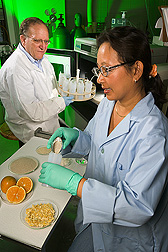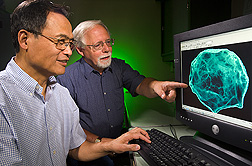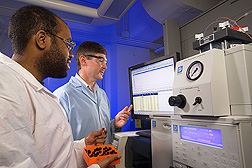Pectin Extraction From Citrus and Sugar Beets
Low-Value Pectin’s a Natural for Making High-Value Products
|
|
At ARS’s Eastern Regional Research Center (ERRC) in Wyndmoor, Pennsylvania, researchers in the Crop Conversion Science and Engineering Research Unit are at work on pectin, a polysaccharide component in the cell walls of fruits and vegetables.
Polysaccharides are polymers made up of many simple carbohydrates (sugars) linked together into long, continuous molecules. Pectin is currently valued for use as a gelling and thickening agent, beverage stabilizer, and fat substitute.
Most commercial pectin is obtained by extraction from citrus peels, but sugar beet pulp is also rich in pectin. About 1.5 million tons of dry beet pulp—an enormous untapped source of a valuable polysaccharide—are generated annually by U.S. processors.
At present, most pulp is dried and sold as animal feed at little profit because of the costly energy required to dry it for storage and shipment.
But sugar beet pectin has different chemical features than citrus pectin, so it could find new uses, especially in industrial products. Beet pulp is also rich in other highly functional cell wall polysaccharides that could be isolated and put to use. To increase profits for sugar beet growers and processors, the Wyndmoor researchers are working on new processes to efficiently isolate beet pectin and associated polysaccharides and find higher value uses for them.
|
|
Extraction of pectin from plant material now takes an hour or more using conventional heating; care must be taken not to break down its structure—which provides thickening properties—by overheating. To save time and reduce cost, Marshall L. Fishman, an ERRC chemist, developed microwave and steam-injection techniques to heat fruit peels with acidified water in pressure-resistant containers.
“Using these ‘flash extraction’ methods, pectin can be extractedin just 10 minutes,” Fishman explains. “They use less energy and yield higher quality pectin than conventional heat extraction.” Fishman is now adapting flash extraction techniques to remove pectin from sugar beet pulp—which is even more heat-sensitive—at lower temperatures than those used to extract pectin from citrus.
Brett Savary, a plant physiologist formerly at ERRC, evaluated enzymes from citrus fruits and sugar beet roots for use in modifying the properties of pectin and other cell wall polysaccharides. He has been using new proteomic technologies to rapidly identify and characterize these enzymes.
With cooperators at the ARS Citrus Products Laboratory in Winter Haven, Florida, Savary discovered a distinctive citrus enzyme that may be useful for commercial processing of pectin. They are filing a patent on the discovery and partnering with a U.S. manufacturer to produce the enzyme and determine its usefulness for manufacturing pectin with improved properties in food applications.
The group is also looking at using enzymes to help dry out beet pulp after sugar extraction, which would reduce processors’ energy costs. It may be possible to combine enzymes with Fishman’s flash extraction technologies to efficiently extract arabinan, another cell wall polysaccharide that could also be commercially produced from sugar beet pulp. With effective recovery of valuable soluble polysaccharides, much of the remaining material is an enriched form of cellulose that’s readily digestible by microbes and could be fermented to produce ethanol.
|
|
Products With Medical Uses
Recently, ERRC chemist LinShu Liu developed a material from natural crop polymers, including pectin, which can be used in biomedical materials, such as those used in human tissue regeneration. The new, pectin-based material forms three-dimensional structures with better physical and mechanical properties than the tissue replacer in current use.
Other potential medical applications of these novel pectin materials include prosthetic medical devices and scaffolding for bone or cartilage repair, since pectin and other polysaccharides have properties that allow human cells to bind to them and grow. A patent application has been filed, and ARS has signed a cooperative research and development agreement with a private company to further develop the materials.
Liu has combined pectin and zein—the main storage protein in corn seeds—and found that the combination can be used in a colon-specific drug-delivery system. It doesn’t degrade until it reaches the large intestine, allowing for controlled release.
In another human health application, plant physiologist Arland T. Hotchkiss and cooperators demonstrated for the first time that pectin fragments from orange peel have prebiotic properties. Prebiotics are nondigestible food ingredients that increase growth of beneficial probiotic bacteria in the large intestine. Probiotic bacteria stimulate health and help prevent growth of foodborne pathogens.
Orange pectin prebiotics are also being evaluated by collaborators as animal-feed ingredients. This may allow reduction or elimination of antibiotics that are often added to feed.
Industrial Uses, Too
Microbial fermentation of sucrose or starch is used to manufacture a polymer known as “polylactic acid,” or PLA, and its copolymers.
At present, PLA is more expensive than petroleum-derived thermoplastics, and its polymers are stiff and brittle in thicker materials. Liu is testing sugar beet pulp as an inexpensive filler to reinforce PLA. The pectin and other polysaccharides in the pulp add tensile strength. Compression heating forms them into a water-resistant, thermoplastic composite material well suited to manufacturing diverse products, such as office supplies, automobile parts, and lightweight construction materials. The improved properties are achieved at lower cost, and the material is biodegradable.
Further refinements of these ERRC-developed pectin-processing techniques should lead to more economical carbohydrate-based alternatives to imported petroleum-based products.—By Jim Core, formerly with ARS.
This research is part of Quality and Utilization of Agricultural Products, an ARS National Program (#306) described on the World Wide Web at www.nps.ars.usda.gov.
To reach scientists mentioned in this article, contact Linda Tokarz, USDA-ARS Information Staff, 5601 Sunnyside Ave., Beltsville, MD 20705-5129; phone (301) 504-1658, fax (301) 504-1486.
"Pectin Extraction From Citrus and Sugar Beets" was published in the February 2007 issue of Agricultural Research magazine.









